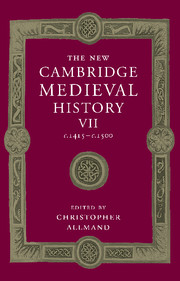Book contents
- Frontmatter
- PART I GOVERNMENT
- PART II ECONOMIC AND SOCIAL DEVELOPMENTS
- PART III SPIRITUAL, CULTURAL AND ARTISTIC LIFE
- PART IV THE DEVELOPMENT OF EUROPEAN STATES
- 17 Germany and the Empire
- 18 Hus, the Hussites and Bohemia
- 19 France
- 20 Burgundy
- 21 England
- 22 The Celtic world
- 23 Italy
- 24 The Iberian peninsula
- 25 The Swiss Confederation
- 26 The States of Scandinavia, c. 1390– c. 1536
- 27 Hungary: Crown and Estates
- 28 The Kingdom of Poland and the Grand Duchy of Lithuania, 1370–1506
- 29 Russia
- 30 Byzantium: The Roman Orthodox World, 1393–1492
- 31 The Latin East
- 32 The Ottoman World
- 33 Conclusion
- Appendix Genealogical Tables
- Primary Sources and Secondary Works Arranged by Chapter
- Index
- Frontispiece
- Plate section
- Map 1 European towns in the late Middle Ages
- Map 2 European commerce and trade
- Map 4 Winds and currents facilitating the discoveries
- Map 5 The universities o f Europe in 1400 and 1500
- Map 6 Germany and the Empire
- Map 20 The Roman Orthodox and Ottoman worlds in the fifteenth century
- References
29 - Russia
from PART IV - THE DEVELOPMENT OF EUROPEAN STATES
Published online by Cambridge University Press: 28 March 2008
- Frontmatter
- PART I GOVERNMENT
- PART II ECONOMIC AND SOCIAL DEVELOPMENTS
- PART III SPIRITUAL, CULTURAL AND ARTISTIC LIFE
- PART IV THE DEVELOPMENT OF EUROPEAN STATES
- 17 Germany and the Empire
- 18 Hus, the Hussites and Bohemia
- 19 France
- 20 Burgundy
- 21 England
- 22 The Celtic world
- 23 Italy
- 24 The Iberian peninsula
- 25 The Swiss Confederation
- 26 The States of Scandinavia, c. 1390– c. 1536
- 27 Hungary: Crown and Estates
- 28 The Kingdom of Poland and the Grand Duchy of Lithuania, 1370–1506
- 29 Russia
- 30 Byzantium: The Roman Orthodox World, 1393–1492
- 31 The Latin East
- 32 The Ottoman World
- 33 Conclusion
- Appendix Genealogical Tables
- Primary Sources and Secondary Works Arranged by Chapter
- Index
- Frontispiece
- Plate section
- Map 1 European towns in the late Middle Ages
- Map 2 European commerce and trade
- Map 4 Winds and currents facilitating the discoveries
- Map 5 The universities o f Europe in 1400 and 1500
- Map 6 Germany and the Empire
- Map 20 The Roman Orthodox and Ottoman worlds in the fifteenth century
- References
Summary
‘Russia’ is the state descended from the grand principality that coalesced around Moscow in the fourteenth century and began the historical continuum that extended to the Russian Empire (1725– 1917), the Soviet Union (1917– 91) and modern Russia. The fifteenth century was one of the most significant, and underappreciated, centuries in Russian history. At the century’s beginning the grand principality of Muscovy stretched from Mozhaisk (about 100 miles to Moscow’s west) eastward to the Suzdal′-Nizhnii Novgorod grand principality (subject in part to Moscow since 1392), from Riazan′ in the south-east to the northern forests of Beloozero, Vologda and Ustiug. But its power was more tenuous than this geographical expanse would suggest. Moscow’s hold in the north and in Suzdal′ was superficial; surrounding Moscow lay myriad principalities ranging from the weak Rostov and Iaroslavl′ to the more potent grand principalities of Riazan′ and Tver′. Powerful rivals included the city republics of Novgorod and Pskov, not forgetting the grand duchy of Lithuania. Yet by the end of the century Moscow had achieved clear dominance in this area often called north-east Rus′ (in reference to the Kiev Rus′ state that flourished from the tenth to the twelfth centuries and bequeathed to Muscovy some important heritages). The key to Moscow’s success lay in the means, both institutional and symbolic, that it devised to consolidate its authority and to exploit and mobilise social resources. Those means of governance and ideological constructions endured for at least the next two centuries, and resonated beyond.
Keywords
- Type
- Chapter
- Information
- The New Cambridge Medieval History , pp. 748 - 770Publisher: Cambridge University PressPrint publication year: 1998

